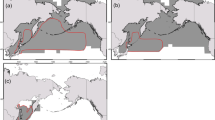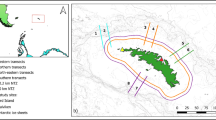Abstract
Migration patterns and habitat use of sub-yearling Chinook salmon during initial ocean entrance is poorly understood. Twenty-five years ago, sub-yearling Chinook salmon were hypothesized to stay close to shore (<5 km). To test this hypothesis we sampled the surf-zone of a southern Oregon dissipative sandy beach throughout the summer of 2006 (06/07–09/29) using a beach seine in 1 m of water depth. We caught 48 sub-yearlings over six dates (07/22 to 09/01). Mean standard length of Chinook salmon caught in the surf-zone increased from 9.1 ± 0.6 (07/22/06) to 11.6 ± 0.7 cm (09/01/06), suggesting a mean increase of 0.6 mm in standard length (S.L.) per day. Early in the summer, smaller fish fed mostly on amphipods. Later in the summer, larger juveniles fed primarily on larval and juvenile fish. All prey items were common in the surf-zone. Juveniles appear to migrate from the estuary to the surf-zone where they feed on the local zooplankton for up to two summer months before migrating offshore.



Similar content being viewed by others
References
Barreiros JP, Figna V, Hostim-Silva M, Santos RS (2004) Seasonal changes in a sandy beach fish assemblage at Canto Grande, Santa Catarina, South Brazil. J Coast Res 20:862–870. doi:10.2112/1551-5036(2004)20[862:SCIASB]2.0.CO;2
Beyst B, Hostens K, Mees J (2002) Factors influencing the spatial variation in fish and macrocrustacean communities in the surf zone of sandy beaches in Belgium. J Mar Biol Assoc U K 82:181–187. doi:10.1017/S0025315402005337
Bottom DL, Jones KK, Cornwell TJ, Gray A, Simenstad CA (2005) Patterns of Chinook salmon migation and residency in the Salmon River Estuary (Oregon). Estuar Coast Shelf Sci 64:79–93. doi:10.1016/j.ecss.2005.02.008
Brodeur RD (1991) Ontogenetic variations in size and type of prey consumed by juvenile coho, Oncorhynchus kisutch and Chinook, O. tshawytscha, salmon. Environ Biol Fishes 30:303–315. doi:10.1007/BF02028846
Brodeur RD, Fisher JP, Teel DJ, Emmett RL, Casillas E, Miller T (2004) Juvenile salmonid distribution, growth, condition, origin, and environmental and species associations in the Northern California Current. Fish Bull (Wash D C) 102(1):25–46
Clark KR, Gorley RN (2001) PRIMER v5: User Manual/Tutorial. PRIMER-E, Plymouth, United Kingdom
Crawley KR, Hyndes GA, Ayvazian SG (2006) Influence of different volumes and types of detached macrophytes on fish community structure in surf zones of sandy beaches. Mar Ecol Prog Ser 307:233–246. doi:10.3354/meps307233
Dawley EM, Sims CW, Ledgerwood RD, Miller DR, Williams JG (1981) A study to define the migrational characteristics of Chinook and coho salmon in the Columbia River estuary and associated marine waters. Coastal Zone and Estuarine Studies Division, Northwest Fisheries Scientific Center, NMFS, Seattle WA
Don C, Fox D, Merems A, Sommer M, Weeks H, Wiedoff B (2006) The Oregon nearshore strategy. Web page: www.dfw.state.or.us/MRP. Newport, Oregon.
Fagerlund UHM, McBride JR, Williams IV (1995) Stress and tolerance. In: Groot C, Margolis L, Clarke WC (eds) Physiological Ecology of Pacific Salmon. U.B.C. Press, Vancouver, Canada, p 510
Fisher JP, Pearcy WG (1995) Distribution, migration, and growth of juvenile Chinook salmon, Oncorhynchus tshawytscha, off Oregon and Washington. Fish Bull (Wash D C) 93:274–289
Fisher JP, Pearcy WG, Chung AW (1984) Studies of juvenile salmonids off the Oregon and Washington coast, 1983. Oregon State University. Oregon Sea Grant College Program ORESU-T-85-004:29 pp
Healey MC (1980) Utilization of the Nanaimo River estuary by juvenile Chinook salmon, Oncorhynchus tshawytscha. Fish Bull (Wash D C) 77:653–668
Healey MC (1983) Coastwide distribution and ocean migration patterns of stream- and ocean-type Chinook salmon, Onchorhynchus tshawytscha. Can Field Nat 97(4):427–433
Healey MC (1991) Life History of Chinook Salmon (Oncorhunchus tshawytscha). In: Groot C, Margolis L (eds) Pacific Salmon Life Histories. UBC Press, Vancouver, Canada, pp 311–395
Keeley ER, Grant JWA (2001) Prey size of salmonid fishes in streams, lakes and oceans. Can J Fish Aquat Sci 58:1122–1132. doi:10.1139/cjfas-58-6-1122
Marin Jarrin JR (2007) The ecology of the surf zone fauna of dissipative sandy beaches in southern Oregon. U.S.A. M.Sc. Thesis, University of Oregon, p 144
McLachlan A, Brown A 2006. The Ecology of Sandy Shores, 2nd edition. Academic
National Marine Fisheries Service 2000. Northwest salmon recovery planning. Recovery planning for west coast salmon. Available online from www.noaa.gov/cbd/trt/overview.htm
Peterson WT, Brodeur RD, Pearcy WG (1982) Food habits of juvenile salmon in the Oregon coastal zone, June 1979. Fish Bull (Wash D C) 80:841–851
Reimers PE (1973) The length of residence of juvenile fall Chinook salmon in Sixes River, Oregon. Oreg Fish Comm Res Rep 4(2):1–43
Ruggerone GT, Goetz GA (2004) Survival of Puget Sound Chinook salmon (Oncorhynchus tshawytscha) in response to climate-induced competition with pink salmon (Oncorhynchus gorbuscha). Can J Fish Aquat Sci 61:1756–1770. doi:10.1139/f04-112
Sato N, Asahida T, Terashima H, Hurbungs MD, Ida H (2008) Species composition and dynamics of larval and juvenile fishes in the surf zone of Mauritius. Environ Biol Fishes 81:229–238. doi:10.1007/s10641-007-9194-9
Schabesberger R, Morgan CA, Brodeur RD, Potts CL, Peterson WT, Emmett RL (2003) Prey selectivity and diel feeding chronology of juvenile Chinook (Oncorhynchus tshawytscha) and coho (O. kisutch) salmon in the Columbia River plume. Fish Oceanogr 12(6):523–540. doi:10.1046/j.1365-2419.2003.00231.x
Silva M, Araújo FG, Costa de Azevedo MC, de Sousa Santos JN (2004) The nursery function of sandy beaches in a Brazilian tropical bay for 0-group anchovies (Teleostei: Engraulidae): diel, seasonal and spatial pattern. J Mar Biol Assoc U K 84:1229–1232. doi:10.1017/S0025315404010719h
Acknowledgements
We would like to thank J. Miller, and C. Young for their invaluable suggestions. Comments from M. Schuiteman and A. Laferriere greatly improved this manuscript. Identification of amphipod species was greatly facilitated by J. Chapman. We are in debt to the many field volunteers who helped with sampling. This work was partly supported by the Myers and Myers grant from Moss Landing Marine Laboratories, and the Neil Richmond Fellowship from the Oregon Institute of Marine Biology. JRMJ was supported by a Fulbright Foreign Student Grant and a University of Oregon Waiver Scholarship.
Author information
Authors and Affiliations
Corresponding author
Rights and permissions
About this article
Cite this article
Marin Jarrin, J.R., Shanks, A.L. & Banks, M.A. Confirmation of the presence and use of sandy beach surf-zones by juvenile Chinook salmon. Environ Biol Fish 85, 119–125 (2009). https://doi.org/10.1007/s10641-009-9470-y
Received:
Accepted:
Published:
Issue Date:
DOI: https://doi.org/10.1007/s10641-009-9470-y




